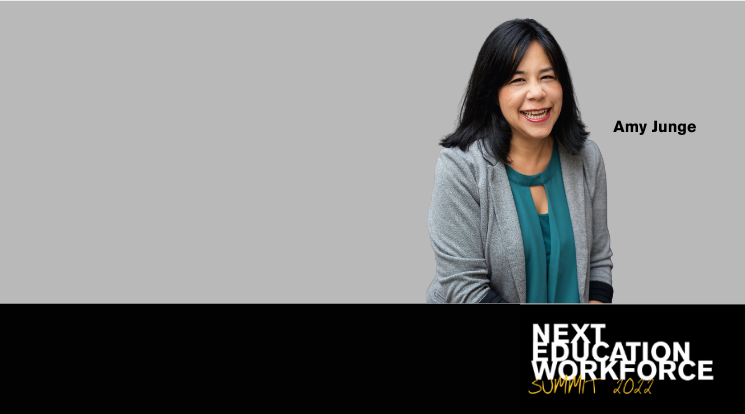What happens when teachers are empowered to make leadership decisions?

The education system that exists today was never designed to meet the needs of all students — or teachers, says Amy Junge, director of Teacher-Powered Schools at Education Evolving.
Junge is one of 15 education leaders who will be featured at the Next Education Workforce Summit 2022, hosted by Arizona State University’s Mary Lou Fulton Teachers College, in February. The virtual event, which will take place over a day and a half, will bring together education leaders, practitioners and experts, and provide the opportunity to collaboratively redesign the education workforce.
Here, Junge reflects on how and where her expertise in teacher-powered governance intersects with the Next Education Workforce.
Q: Your expertise is in collaborative leadership structures, specifically teacher-powered governance. What connections do you see between your work and the Next Education Workforce, where teams of educators come around students to deliver on the promise of deepened and personalized learning for ALL students?
Junge: Teacher-powered schools are a means to create equitable, high-quality, culturally affirming, student-centered learning environments. At the end of the day, we do our work with, and for the benefit of students. When teams of teachers work together, they keep students at the center of their design choices and decision-making. This space allows each educator team to create the best personalized learning space for students. This will look different at every school because each school serves a unique set of students and families.
What have you seen in your life and work that’s convinced you we need a different model of schooling and learning?
My first teaching position was at an elementary school in an underserved community with many high-needs students, English language learners and students experiencing poverty. Many students had foundational needs that were not being met before they ever entered our campus. These students and families needed a school model that provided support to not only close achievement gaps, but also a model that celebrated skills and accomplishments, personalized learning and engaged families as true partners.
My other big shift in educational thinking came as we researched the book “Trusting Teachers With School Success: What Happens When Teachers Call the Shots.” As we visited almost a dozen schools who used collaborative leadership models, everything I thought I understood about leadership and school governance was challenged. These schools lived the values of collective teacher agency and ownership, and then turned around and created learning programs where student voice and choice thrived. It was a completely different governance and educational philosophy than I had ever encountered. It changed what I knew was possible.
People frequently talk about equity in education, and sometimes it seems they are not talking about the same thing. What do you think we should mean when we talk about equity in education?
When we talk about equity at Teacher-Powered, we think in terms of design, structures and practices teams engage in at schools. As we create student-centered schools designed to meet the needs of all students we know that traditional education systems, structures and practices were not designed for this end. In fact, the system not only reflects industrial age concepts of teaching and learning, it was never designed to meet the needs of all students and it wasn’t designed for equity for students or equity for teachers.
Teacher-Powered works to break this cycle by moving decisions closer to the educators who are working with the students each day. Educators who understand students as whole people, have collective power to make immediate changes and do what is best for the students.
What approaches have you seen used by school and district administrators who are successful in creating systems-level changes to educator staffing models? Can you give us a specific example?
The most successful systems-level changes to educator staffing models have come from schools, districts or authorizers that have created opportunities for educator teams to have more autonomy in exchange for accountability. Hiring autonomy is arguably the most important potential autonomy a school can have. If we want teachers to collaboratively lead together, we must allow them the ability to make staffing decisions.
When this is done well staff turnover is very low, teacher job satisfaction is high and decision making is more effective and efficient. In the pilot school models in Boston and Los Angeles, schools have hiring autonomy and each team creates an agreed-upon Elect to Work Agreement that holds each teacher accountable to a set of working conditions outside of the negotiated contract. Some schools add extra meeting time for shared decision making, some add required supervision of extra student activities or availability for families.
What about the education policy landscape needs to happen — or stop happening — for the U.S. to achieve sustainable, equitable gains in learning outcomes?
We need to expand our thinking about what is possible in K–12 education. School doesn’t have to look like or feel like the school almost all of us grew up going to. Education policy needs to embrace school redesign that shares power with educators (including paraprofessionals), students (at all grade levels), and families and communities.
Is there anything else you want the audience to know, think about or takeaway?
Educators are tired. Not only from the pandemic, but from a system that isn’t sustainable and isn’t serving students well. There are better ways. Not one solution, but hundreds of solutions. I believe that the answers to these questions will come from educators within our profession — those who know and believe in the students and families they serve. As we recreate these systems we must build structures and practices that nurture our teacher teams as much as nurture students. Collaboration, community and shared purpose are at the center of this work.
Enjoyed the conversation?
Hear more from Amy Junge on distributed expertise and research outcomes at her featured expert sessions at the Next Education Workforce Summit on Feb. 2, 2022.